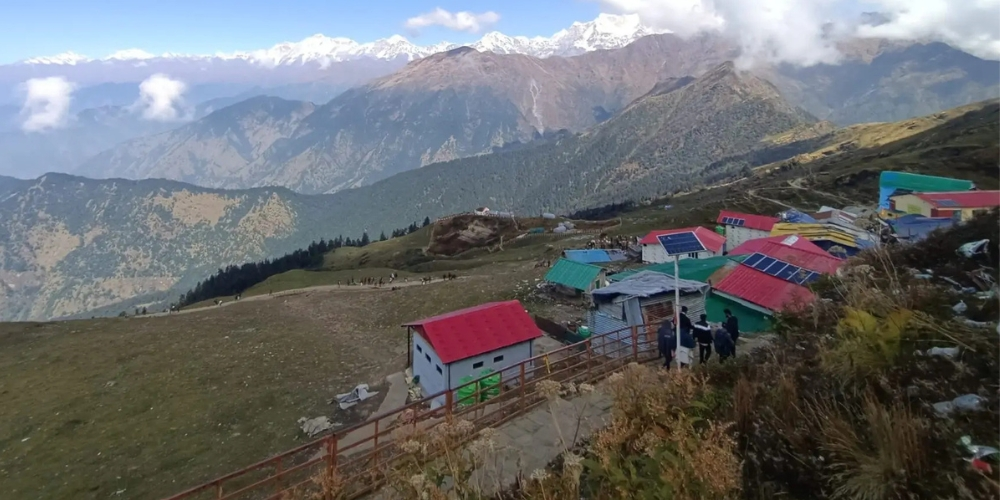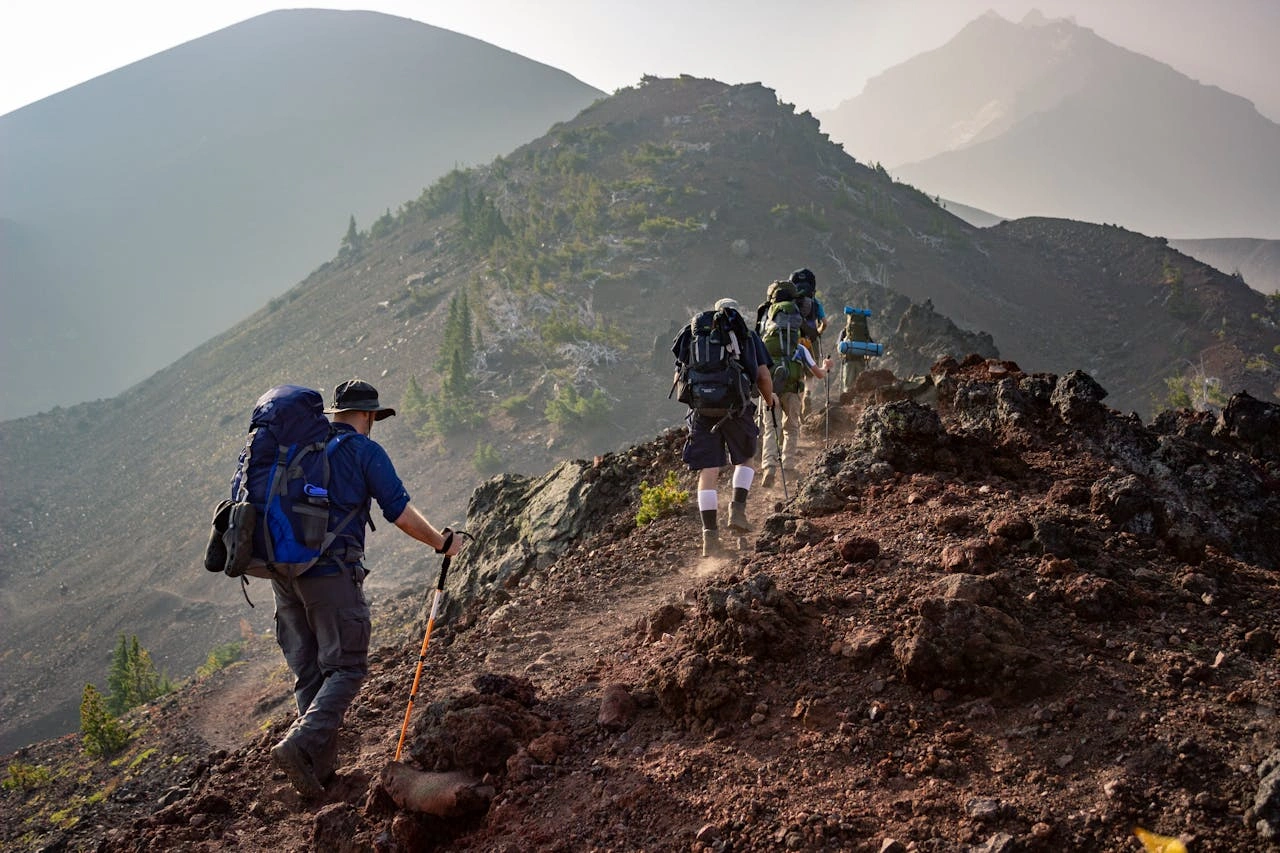
Chopta Chandrashila journey, a perfect adventure for newcomers and nature suckers likewise. This beautiful journey leads you to Tungnath, the loftiest Shiva temple in the world, before climbing further to Chandrashila Peak. Once you reach here, you’ll want to just stand still and take it all in — a full 360° view of the Himalayas with Nanda Devi and Trishul proudly watching over you. Blending adventure, spirituality, and natural beauty, the Chopta Chandrashila trek is considered one of the most stylish short Himalayan treks, ideal for those craving mountain sunrises and sacred sanctuaries in a single, unforgettable trip.
Complete Trek Distances and Route Breakdown
Let’s talk about the part every mountaineer wants to know before lacing up their thrills: the journey distance! The good news? This is a short, beginner-friendly Himalayan journey that offers indelible views without requiring days of strenuous walking.
The Chopta Chandrashila Tungnath journey officially starts from the lovely little village of Chopta, situated at an altitude of around 2,680 meters. From there, the trail takes you through thick timbers of oak and rhododendrons, gradually leading you to the sacred Tungnath Temple. The Chopta to Tungnath trek distance is approximately 3.5 to 4 km, and it generally takes about 1.5 to 2 hours, depending on your pace and how often you pause to take in the incredible Himalayan views.
After soaking in the calm, spiritual vibe at Tungnath, the highest Shiva temple in the world, it’s time to set your sights on the real showstopper — Chandrashila Peak. The distance from Tungnath to Chandrashila is just 1.5 km, but don’t let the number fool you. This final stretch is a little steeper and can be a challenge, especially if the trail’s blanketed in snow.
All in all, the total trek distance is around 5 to 5.5 km one way, and you can comfortably complete the whole journey — with plenty of tea breaks, photo stops, and breath-catching moments — in about 4 to 5 hours round trip. And trust us, with those jaw-dropping Himalayan views along the way, you’ll be stopping often.
Pro Tip: Yes, it’s a 5 km journey one way — but theview from Chandrashila summit is pure magic. Sunrise views will then stay with you for a long time!
Best Time to Visit Chopta Chandrashila Trek
Wondering when’s the best time to visit Chopta Chandrashila? It really depends on what kind of journey you expect. However, the sound of cold air and the flower headendron are perfect if the sky is clear.
Love clear skies, cool weather, and trails bursting with bright rhododendrons? Head there in spring (March to May). Prefer those crisp mountain mornings and snow-dusted peaks? Autumn (September to November) is your season.
And if you’re someone who dreams of walking through fresh snow, the winter trek from December to February is pure magic. It’s colder, sure — but the snow-covered landscapes will make you forget about the chill. Whichever season you pick, this trek never disappoints.
Trek Difficulty, Duration, and Who It’s For
The Chopta Tungnath trek is considered one of the easiest high-altitude treks in the Himalayas, making it perfect for both first-timers and seasoned hikers. Whether you’re a solo traveler chasing solitude, a nature photographer hunting for surreal sunrises, or a beginner eager to test your stamina, this trail has something for everyone. The trek covers about 4 km from Chopta to Tungnath, followed by another 1.5 km to Chandrashila, and can comfortably be done in 1 to 2 days. What’s great is you can choose the right season to match your vibe — spring for blooming rhododendrons, winter for snow-covered trails, or autumn for crystal-clear mountain skies.
Pro Tip: Start light cardio and daily walks a few weeks before your trek to build stamina — it’ll make a big difference when the altitude starts to test you!
How to Reach Chopta
Planning to reach Chopta? It’s simpler than you might think. The easiest way is to hit the road from Rishikesh, about 200 km away. The drive takes around 7 to 8 hours, and trust me — the scenic mountain views along the way are worth every minute. Most people stop at Ukhimath, the last lively city, before they come back to Chopta. If you want to break the journey, it’s a great place to catch food or stop at night. Whether you are driving yourself or hiring a taxi, the trip sets the perfect atmosphere for your trip.
What Makes Chandrashila Trek Famous
If there’s one thing the Chandrashila trek is known for, it’s the sunrise from its summit. Imagine standing at a distance of 4000 meters, looking at the first shaft of huge peaks such as Nanda Devi, Trishul, and Chaukhamba; this is a moment that stops you in your tracks. Chandrashila leaves you speechless, not just because of what’s in front of your eyes, but because of the calm it brings to your heart on your way over. The ancient Tungnath Temple, known as the loftiest Shiva tabernacle in the world, adds a spiritual touch to the adventure. It’s one of those treks you’ll talk about for a long time.
Optional Trek Packages
Many travel operators offer a full Trek package for the first time for those who go on the trip or are just looking for a practical experience. These packages usually begin with Rishikesh or Chopta and include housing, all food, essential permits, and guidance from a skilled Trek leader. These packages are perfect for individuals and groups and take care of the plan so you can fully enjoy the trip and focus on incredible ideas and experiences without worrying about the details.
Pro Tips and Essential Info
- Carry warm layers and quality trekking shoes, as the weather near Chandrashila Peak can get chilly, especially in the early mornings and evenings.
- Start early to reach Chandrashila by sunrise — the panoramic Himalayan views at dawn are truly unforgettable.
- Stay hydrated throughout the trek; the high altitude can quickly dehydrate you without realizing it.
- Respect temple customs at Tungnath, as this trek also includes a visit to the revered Tungnath temple, the highest Shiva temple in the world.
- The Tungnath trek is considered one of the most beginner-friendly high-altitude treks, making it perfect for first-timers and solo adventurers alike.
Conclusion
Chopta Chandrashila Trek is one of the rare Himalaya adventures that beautifully mix spirituality, nature, early morning, and other trekking activities. Chopta is a small, fantastic ground station that acts as the perfect base for this trip and offers juicy grasslands and crisp air. The Chandrashila walk is at a height where the panoramic view of the powerful Himalayas rewards all your efforts. Whether you are looking for peace, adventure, or Instagram-worthy sunrise shots, this walk guarantees an experience you want to give relief over and over.


